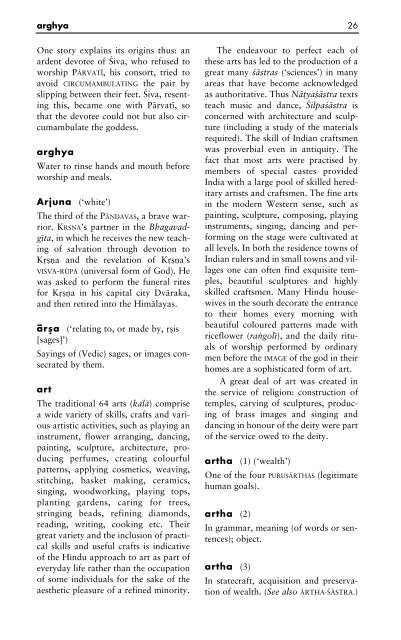A Concise Encyclopedia of Hinduism Klaus K Klostermaie
Create successful ePaper yourself
Turn your PDF publications into a flip-book with our unique Google optimized e-Paper software.
arghya 26<br />
One story explains its origins thus: an<br />
ardent devotee <strong>of</strong> Ÿiva, who refused to<br />
worship PÄRVATÏ, his consort, tried to<br />
avoid CIRCUMAMBULATING the pair by<br />
slipping between their feet. Ÿiva, resenting<br />
this, became one with Pärvatï, so<br />
that the devotee could not but also circumambulate<br />
the goddess.<br />
arghya<br />
Water to rinse hands and mouth before<br />
worship and meals.<br />
Arjuna (‘white’)<br />
The third <strong>of</strong> the PÄŒ¥AVAS, a brave warrior.<br />
KØÆŒA’s partner in the Bhagavadgïta,<br />
in which he receives the new teaching<br />
<strong>of</strong> salvation through devotion to<br />
Kø•æa and the revelation <strong>of</strong> Kø•æa’s<br />
VIŸVA-RÜPA (universal form <strong>of</strong> God). He<br />
was asked to perform the funeral rites<br />
for Kø•æa in his capital city Dväraka,<br />
and then retired into the Himälayas.<br />
är•a (‘relating to, or made by, ø•is<br />
[sages]’)<br />
Sayings <strong>of</strong> (Vedic) sages, or images consecrated<br />
by them.<br />
art<br />
The traditional 64 arts (kalä) comprise<br />
a wide variety <strong>of</strong> skills, crafts and various<br />
artistic activities, such as playing an<br />
instrument, flower arranging, dancing,<br />
painting, sculpture, architecture, producing<br />
perfumes, creating colourful<br />
patterns, applying cosmetics, weaving,<br />
stitching, basket making, ceramics,<br />
singing, woodworking, playing tops,<br />
planting gardens, caring for trees,<br />
stringing beads, refining diamonds,<br />
reading, writing, cooking etc. Their<br />
great variety and the inclusion <strong>of</strong> practical<br />
skills and useful crafts is indicative<br />
<strong>of</strong> the Hindu approach to art as part <strong>of</strong><br />
everyday life rather than the occupation<br />
<strong>of</strong> some individuals for the sake <strong>of</strong> the<br />
aesthetic pleasure <strong>of</strong> a refined minority.<br />
The endeavour to perfect each <strong>of</strong><br />
these arts has led to the production <strong>of</strong> a<br />
great many ÿästras (‘sciences’) in many<br />
areas that have become acknowledged<br />
as authoritative. Thus Näflyaÿästra texts<br />
teach music and dance, Ÿilpaÿästra is<br />
concerned with architecture and sculpture<br />
(including a study <strong>of</strong> the materials<br />
required). The skill <strong>of</strong> Indian craftsmen<br />
was proverbial even in antiquity. The<br />
fact that most arts were practised by<br />
members <strong>of</strong> special castes provided<br />
India with a large pool <strong>of</strong> skilled hereditary<br />
artists and craftsmen. The fine arts<br />
in the modern Western sense, such as<br />
painting, sculpture, composing, playing<br />
instruments, singing, dancing and performing<br />
on the stage were cultivated at<br />
all levels. In both the residence towns <strong>of</strong><br />
Indian rulers and in small towns and villages<br />
one can <strong>of</strong>ten find exquisite temples,<br />
beautiful sculptures and highly<br />
skilled craftsmen. Many Hindu housewives<br />
in the south decorate the entrance<br />
to their homes every morning with<br />
beautiful coloured patterns made with<br />
riceflower (raögolï), and the daily rituals<br />
<strong>of</strong> worship performed by ordinary<br />
men before the IMAGE <strong>of</strong> the god in their<br />
homes are a sophisticated form <strong>of</strong> art.<br />
A great deal <strong>of</strong> art was created in<br />
the service <strong>of</strong> religion: construction <strong>of</strong><br />
temples, carving <strong>of</strong> sculptures, producing<br />
<strong>of</strong> brass images and singing and<br />
dancing in honour <strong>of</strong> the deity were part<br />
<strong>of</strong> the service owed to the deity.<br />
artha (1) (‘wealth’)<br />
One <strong>of</strong> the four PURUÆÄRTHAS (legitimate<br />
human goals).<br />
artha (2)<br />
In grammar, meaning (<strong>of</strong> words or sentences);<br />
object.<br />
artha (3)<br />
In statecraft, acquisition and preservation<br />
<strong>of</strong> wealth. (See also ÄRTHA-ŸÄSTRA.)


















